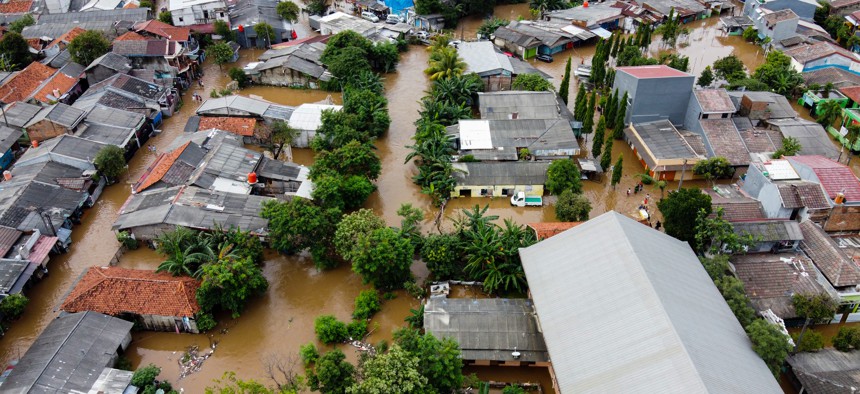Smart, Proactive Land Management Crucial as Flooding Intensifies

istock.com/syahrir maulana
COMMENTARY | Here are four ways to avoid the loss of life and expansive and expensive property damage while maintaining healthy watersheds.
The United States experienced historic flooding in 2019. With a deluge of rainfall extending from the Southeast to the Midwest, the country saw an average of 34.78 inches of rain, which is 4.84 inches above the long-term average.
Although many people hoped for a respite in 2020, the flooding threat didn’t abate. Coasts in the United States were battered by a record number of hurricanes, forcing meteorologists to turn to the Greek alphabet to refer to storms after running out of names on the preestablished list.
Coping with the Cost
Flooding certainly isn’t a new phenomenon, but it’s getting worse as human infrastructure expands and climate change contributes to rising sea levels and more extreme weather events. Major floods have plenty of immediate consequences, including property damage, displacement, injury and death. But many consequences are felt long after the floodwaters have receded.
Floods cause long-term health complications ranging from waterborne diseases to trauma and mental health issues. Additionally, economic impacts linger due to interruptions in commerce, tourism and agriculture. Depending on the community’s resilience, natural assets, parks and civic institutions can take years to rebuild—depleting services, decreasing safety and sanitation, draining emergency funds and reducing the overall quality of life.
Although it would be impossible (and unwise) to try to prevent flooding, it is important to manage land proactively to allow for it. With some of the following strategies in place, land can naturally filter floodwater and return it to creeks and rivers, avoiding injury or death and expensive property damage while maintaining healthy habitats and watersheds.
1. Work with the natural landscape to create minimal impact on water flow.
Managing land to work with nature’s expected cycles is the best way to ensure minimal negative impacts on communities and environments. One effective way to avoid catastrophic flooding, for example, is by avoiding development in floodplains and, instead, giving flood-prone waterways the space to flood. Not only is this the most effective option, but it’s also the simplest and most affordable.
Greenways, for example, are designed to withstand flooding events. Instead of developing right up to a river’s edge, incorporate social infrastructure such as parks and greenways to provide resiliency during floods with the least impact on the environment—while also giving people spaces for outdoor recreation.
2. Offset gray infrastructure with blue-green practices.
In recent years, Portland, Oregon, has been a shining example of smart flood management and the power of green infrastructure programs, but it wasn’t always that way. In the 1990s, several floods ended up discharging sewage into the Willamette River, eventually sparking a “Grey to Green” initiative in 2008 to develop more “green” infrastructure, which depends on natural and environmental features rather than “grey” infrastructure like concrete and steel to manage stormwater, conserve natural areas and make watersheds healthier.
By implementing more than 2,000 runoff channels, building 600 vegetated eco-roofs and planting thousands of trees in the otherwise urban landscape, Portland has mitigated the worst of its flooding issues and created a more resilient landscape in the face of disaster.
3. Reintroduce native vegetation to absorb rainfall and mitigate flooding.
As you work to offset gray infrastructure with more greenery, be sure to incorporate native trees and vegetation. Plants are natural reservoirs and can trap substantial volumes of water that would otherwise become runoff. Even when a tree can no longer absorb additional water, its canopy catches some water on the way to the ground. This, along with the tree’s roots, helps to slow runoff. Many native plants have especially deep root systems that allow them to store more water and prevent more runoff and flooding than non-native species.
4. Use permeable paving materials.
The proliferation of asphalt roads and concrete sidewalks throughout urban areas creates an impermeable surface that can turn even a light rain into a rushing torrent of water. Permeable pavement decreases surface runoff and peak flood flow by allowing some water to soak into the ground. As a result, localities with permeable pavement can handle more rain than a similar area with conventional paving materials.
New Orleans has used permeable paving to great effect in parking lanes and sidewalks. And the city council recently passed a mandate requiring these materials in all new road projects. Thanks to smart design, the sewerage and water board’s drainage system is under less stress to pump out water collecting on impermeable surfaces.
When natural disasters strike, they often seem to come out of nowhere and catch communities by surprise. The reality is that catastrophes such as floods are quite predictable, and we know they’re likely to increase in size and scope in the coming years. With this knowledge comes a responsibility to plan for floods and make smart land management choices that mitigate their risk, preserve ecosystems and protect communities.
Todd Antoine is a member of the Urban Land Institute and vice president of planning and projects at Great Rivers Greenway, the public agency that plans and builds networks of greenways that connect the St. Louis region.
NEXT STORY: Will the Housing Market Ever Be Normal Again?





